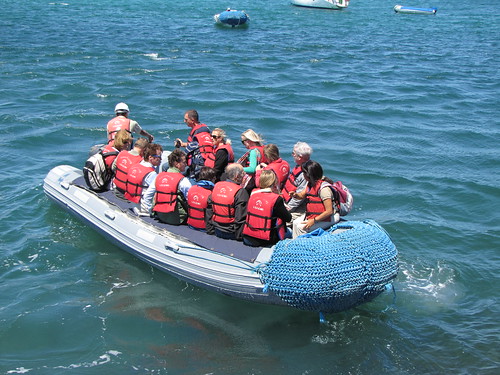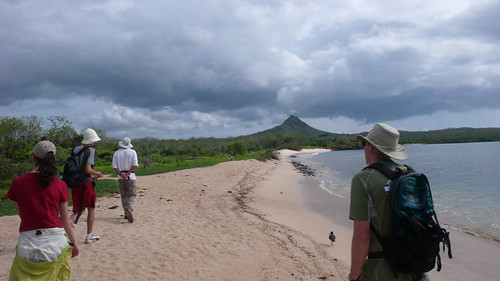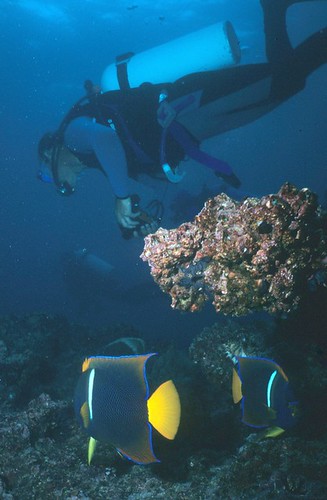The voyage of discovery around the world the British ship HMS Beagle lasted five years. On board was the young scientist Charles Darwin, invited by Captain FitzRoy to help in the geological and topographic. In the course of the expedition Darwin did research in many places, but none were as significant as the study of species of fauna of the Galapagos Islands. And little could think of Darwin that his short stay in the archipelago, September and October 1835, should lead to a change so radical in their ideas and upset all hitherto existing theories about the permanence of species.

Photography by David Berkowitz
Tour of Darwin:
The first island was visited by Darwin in San Cristobal, on the sixth day he moved to Floreana. Both focused on the task of describing the landscape including geological observations, observe the flora and finches and tortoises. Days later sailed to the island Isabela. They changed the priorities in their field work. Just realize that the wildlife around him was something peculiar, was similar to that of the previous islands, but not quite as well in animals were aspects that were shocking.
Darwin was surprised at the absence of mammals. He was shocked to see that birds and reptiles did not escape its path, to the point of leaving written in his diary that with a stick could bring down any bird on a branch or even, some dare to put on his back. Another thing that aroused his curiosity was the presence of unknown giant tortoises and lizards. Since that time devoted much efforts to collect specimens of wildlife. Especially focused his remarks on the family of finches (finches), the jesters (Mimidae) and giant tortoises (Geochelone elephantophus), not forgetting to investigate marine iguanas (Amblyrhynchus cristatus). The attention was so feverish that conveniently forgot to label the finches, and this fact would help years later, in his theory of evolution of species in the Galapagos.
When Darwin returned to Britain he remained convinced that species were immutable. It took several years of thorough studies and animal samples collected in the Galapagos to begin to get an idea of what should be his revolutionary theory. It is known the witness appeared in a letter when he was 68 years: «When I was on board the Beagle I believed in the durability of the species, but how far I can remember, vague doubts I had hovered over his head. Back home in the fall of 1836 I began to prepare the publication of my Journal and it was then that I realized a lot of facts indicating that many species came from a common ancestry. Thus, in 1837 started a notebook where you write any fact referring to the variability. But I’m not convinced that species were mutable until, I think, after two or three years».

Photography by cdorobek
Studies of the species of Darwin:
The laboratory work is based mainly on the finches, aided by the ornithologist John Gould. The noise of birds comes to discern unlabeled 13 species. All finches were similar to those found in the Americas but with different factions and different eating habits and also what Darwin was intrigued with the problem of distribution.
The geological history of the Galapagos was one of the assumptions used to assert the theory of evolution. The origin is volcanic eruptions first fruit of underwater and then surface. The volcanic material accumulated on a shallow shelf at the Carnegie underwater mountain range. About five million years older islands emerged and the newest in for only a million. The archipelago has never been in contact with the mainland.
The study of finches served as the basis of the Darwinian theory: some examples of finches arrived on the islands scattered adapted to different ecological niches, creating several distinct populations. Over time, each population has evolved into different species of Darwin finches. The diversity of these birds is due to the structure of the bill and eating habits. As they eat has a kind of peak power and varies in each species. There are those who are insectivorous, some eat seeds, ticks turtles, leaves, flowers, and even a species that drinks blood of seabirds. The two species have adopted a more sophisticated power are those that use twigs or cactus spines to extract insects from tree bark, if unusual among birds.

Photography by derekkeats
Turtle observations were less accurate than those of the finches, it took only a few specimens. Subsequent studies have concluded that there are two species and a total of fourteen varieties. While the same species of finches can be found, with exceptions, on several islands, turtles are different on each island. It turns out that there are five varieties Isabela Island turtle, each community is separated by impassable lava terrain.
It’s been 176 years since Darwin’s visit. The islands have seen the established settlers from the continent, began to till the land and introduce new plants and animals outside. Recently, tourism has begun to arrive from around the world. Of all these developments, which appear more dangerous to the ecological balance is derived from the settlers, they became predators, the worst the goat, which changed the face of some island plant. Cats and rats have become enemies of the young iguanas and turtles. Introduced plants are a plague, especially the mulberry (Rubus niveus). National park staff devotes extensive efforts in the fight against more aggressive species, whether plant or animal. In Charles Darwin Biological Station in Puerto Ayora are studying the impact it can have a fly that lays in the nests of finches, it is unknown how the islands entered also and more important as a control, the larvae of these flies enter blood of chickens and go kill them.
Tourism in the Galapagos Islands:
Regulations affecting tourism are strict. There are islands where it is prohibited to land, others can only do a limited number of people per month. In areas where it is permitted to view, it is required the presence of a national park guide. So the tourists, although they may enjoy the spectacle of 27 endemic animal species, 29 indigenous and migratory enough of, all remain as calm as in the days of Darwin.
With residents and tourists, the Galapagos are still an unusual place. Visit the archipelago is one of the most enriching experiences for anyone. Darwin, after seeing the islands, said: «It was the most important event of my life … a real workout since he had to devote attention to several branches of natural history and that forced me to improve and strengthen my powers of observation».
Good Luck!
2 Responses to “Ecuador: Galapagos Islands Travel”
Leave a Reply
You must be logged in to post a comment.
marzo 18th, 2012 at 12:35 pm
[…] enthusiasts can climb the sacred mountain of the island, Misen san, whose summit is reached in about two hours walk and from which you can see the […]
marzo 18th, 2012 at 5:45 pm
[…] islands are uninhabited area and visit if you have the possibility of adventure tourism. One of the islands is named after the famous British secret agent, James Bond, since it was filmed the movie […]